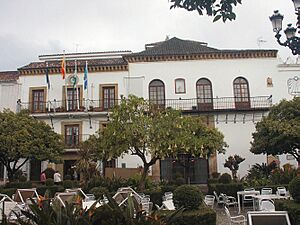Casa consistorial de Marbella facts for kids
The Casa Consistorial De Marbella is a very old and important building in the city of Marbella, located in southern Spain. It's like the main office for the city's leaders, also known as the town hall. This beautiful building was finished in 1568, which means it's over 450 years old!
You can find it in the historic part of Marbella, in a lovely square called Plaza de los Naranjos (which means "Orange Tree Square"). The building was built in a style called Renaissance, which was popular a long time ago and is known for its grand and balanced designs.
On the outside of the building, you can see some cool features. There's a sundial, which tells time using the sun's shadow, and a special symbol called a coat of arms. There are also old stone plaques with writing in Old Spanish. These plaques tell stories from history, like when the city was taken over in 1485 by the Catholic Monarchs, Ferdinand and Isabella. Another plaque remembers when the city got its water supply in 1632, and another marks additions made to the building in 1779.
Contents
What is a Town Hall?
A town hall, or "Casa Consistorial" in Spanish, is the main building where a city's government works. It's where the mayor and other city officials have their offices. They meet there to make important decisions about the city, like how to manage parks, roads, and other services for the people who live there. It's a central place for local government.
History of the Building
The Casa Consistorial De Marbella has a long and interesting history. It was built during a time when Spain was a very powerful country. The year 1568, when it was completed, was during the Renaissance period in Europe. This era was famous for new ideas in art, science, and building design.
Important Dates on the Plaques
The plaques on the building tell us about key moments in Marbella's past:
- 1485: This year marks when the city of Marbella was conquered by the Catholic Monarchs, King Ferdinand II of Aragon and Queen Isabella I of Castile. This event was part of a larger historical period when different kingdoms in Spain were united.
- 1632: This plaque celebrates a big improvement for the city: the establishment of its water supply. Having a good water system was very important for people living in the city, making life much easier and healthier.
- 1779: This date shows when parts of the building were added or changed. Buildings like the Casa Consistorial often grow and change over many years to meet the needs of the city.
Renaissance Style Architecture
The Renaissance style of architecture, seen in the Casa Consistorial, came from Italy and spread across Europe. It brought back ideas from ancient Roman and Greek buildings. This style often includes:
- Symmetry: Buildings look balanced on both sides.
- Columns: Often decorative pillars.
- Arches: Rounded openings for doors and windows.
- Domes: Large, rounded roofs.
The Casa Consistorial shows some of these classic features, making it a beautiful example of this historical building style in Spain.
Location in Plaza de los Naranjos
The building's location in the Plaza de los Naranjos is very special. This square is one of the most famous and beautiful spots in Marbella's old town. It's a lively place where people gather, surrounded by orange trees, cafes, and other historic buildings. Being in such a central and picturesque location highlights the importance of the Casa Consistorial to the city.
See also
 In Spanish: Casa Consistorial de Marbella para niños
In Spanish: Casa Consistorial de Marbella para niños


